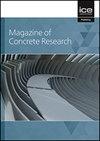Characterization and standardization of different-origin end-of-life building materials toward assessment of circularity performance
IF 1.8
4区 工程技术
Q3 CONSTRUCTION & BUILDING TECHNOLOGY
引用次数: 0
Abstract
Construction and demolition waste (CDW) management and recycling practices are crucial for transitioning to a circular economy. The focus of this study was on the detailed characterisation of different CDWs (hollow brick (HB), red clay brick (RCB), roof tile (RT), concrete and glass) collected from seven different demolition sites in Turkey. The CDWs were characterised based on particle size distribution, chemical composition and crystalline nature. Pozzolanic activity was evaluated through compressive strength measurements of cement mortars made with 20% cement replacement by CDWs at 7, 28 and 90 days. The results showed that the clayey CDWs exhibited similar physical/chemical properties and crystalline structures. The compositions of the waste concretes varied significantly based on their original materials. All the CDWs satisfied the minimum strength activity index (SAI) for supplementary cementitious materials, with pozzolanic activity influenced by the fineness and silica + alumina contents. The average SAIs for the HB, RCB, RT, concrete and glass were, respectively, 84.5%, 86.3%, 83.4%, 80.7% and 75.8%. Clayey CDWs contributed to mechanical strength development, while the contribution of concretes was related to the hydration of unreacted cementitious particles. Glass exhibited the weakest pozzolanic activity due to its coarser particle size. Overall, the CDWs demonstrated suitable properties for use as supplementary cementitious materials in Portland cement based systems.面向循环性能评估的不同来源的报废建筑材料的特性和标准化
建筑和拆迁废物(CDW)的管理和回收做法对于向循环经济过渡至关重要。本研究的重点是从土耳其七个不同的拆迁地点收集的不同cdw(空心砖(HB),红粘土砖(RCB),屋顶瓦(RT),混凝土和玻璃)的详细特征。根据cdw的粒度分布、化学成分和结晶性质对其进行了表征。在第7天、第28天和第90天,通过测量含20% CDWs水泥的水泥砂浆的抗压强度来评估火山灰活性。结果表明,粘土质cdw具有相似的物理化学性质和晶体结构。废混凝土的成分因其原始材料的不同而有很大差异。所有CDWs均满足补充胶凝材料的最小强度活性指数(SAI),火山灰活性受细度和二氧化硅+氧化铝含量的影响。HB、RCB、RT、混凝土和玻璃的平均SAIs分别为84.5%、86.3%、83.4%、80.7%和75.8%。黏性cdw对机械强度的发展有贡献,而混凝土的贡献与未反应胶凝颗粒的水化有关。玻璃由于粒径较大,其火山灰活性最弱。总的来说,cdw表现出了作为波特兰水泥基体系补充胶凝材料的合适性能。
本文章由计算机程序翻译,如有差异,请以英文原文为准。
求助全文
约1分钟内获得全文
求助全文
来源期刊

Magazine of Concrete Research
工程技术-材料科学:综合
CiteScore
4.60
自引率
11.10%
发文量
102
审稿时长
5 months
期刊介绍:
For concrete and other cementitious derivatives to be developed further, we need to understand the use of alternative hydraulically active materials used in combination with plain Portland Cement, sustainability and durability issues. Both fundamental and best practice issues need to be addressed.
Magazine of Concrete Research covers every aspect of concrete manufacture and behaviour from performance and evaluation of constituent materials to mix design, testing, durability, structural analysis and composite construction.
 求助内容:
求助内容: 应助结果提醒方式:
应助结果提醒方式:


